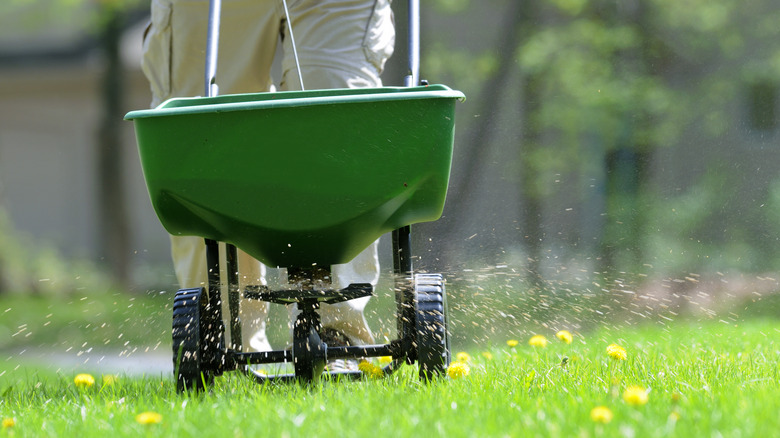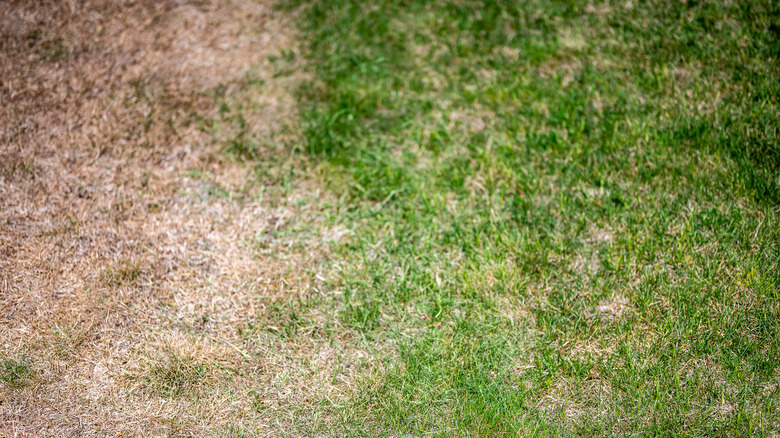Can You Use Lawn Fertilizer At The Same Time As Weed And Feed?
Lawn fertilizer is an essential component in maintaining a healthy, vibrant lawn. It's a product specifically formulated to provide essential nutrients to your lawn, such as nitrogen, phosphorus, and potassium (NPK). These nutrients promote healthy grass growth, root development, and overall lawn vigor. Meanwhile, weed and feed is a combination product designed to simultaneously fertilize your lawn and control weeds. It typically contains herbicides to target weeds like dandelions, clover, and crabgrass, along with fertilizers to nourish your grass. Now, the big question: Can you use lawn fertilizer at the same time as weed and feed? The short answer is: No, you shouldn't. There are not-so-great consequences of using both products together, so lawn experts advise against it.
According to LSU AgCenter horticulturist Dan Gill writing on nola.com, "Whatever you do, you must not apply a weed and feed and then turn around and apply a lawn fertilizer. You will over-fertilize the lawn and may damage the grass. Use one or the other, not both."
Why you shouldn't use both products simultaneously
Using lawn fertilizer and weed and feed together can have negative consequences. Over-fertilization can lead to fertilizer burn or crispy yellowing (or even dead) turf and excessive yet weak growth, which may make your lawn more susceptible to diseases and pests. The herbicides in weed and feed can harm beneficial organisms in the soil and negatively impact soil health over time. Furthermore, applying both products simultaneously increases the risk of chemical runoff, which can pollute waterways and wreak havoc on the environment.
Beyond putting your lawn at risk, the chemical ingredients in weed and feed can also be harmful to humans and animals. Research has found a link between the 2,4-D chemical pesticide and an increased risk of cancer in humans. Birds have been known to ingest weed and feed granules with fatal results. With these risks, it is absolutely essential to follow product package instructions carefully and consider the environmental impact of your lawn care practices. The herbicide in weed and feed is non-selective, meaning this product can also harm desirable garden plants. Therefore, always apply it with caution to ensure it is distributed only in target areas of your turf.
Lawn care tips
To achieve a lush, healthy lawn, apply fertilizer and your chosen herbicide as separate products, or use weed and feed exclusively. For lawn fertilization, it's best to apply fertilizer in the early spring and fall when grass is actively growing. Choose a slow-release fertilizer to provide nutrients gradually over time, reducing the risk of burn and promoting steady growth. Identify the types of weeds you want to target before selecting a weed killer as different herbicides are formulated to target specific types of weeds. Apply weed killer when weeds are actively growing and most susceptible to treatment, usually in early spring and late summer or early fall, depending on the type of weed and your location.
If you wish to use weed and feed, apply it when temperatures reach 60 degrees Fahrenheit and above, the grass is established and in good health, and weeds start to appear. Avoid application during extreme heat or drought conditions, as this can stress the grass and reduce the effectiveness of the herbicide. Avoid using weed and feed during windy weather to prevent drift and unintended application in non-target areas. Water your lawn lightly to help activate the herbicide and promote absorption into the weeds' foliage. Whichever products you opt to use, follow the manufacturer's instructions on the product label carefully, pay attention to recommended formulation and application rates, and wear appropriate protective gear. Keep children and pets away from treated areas until the product has dried completely.


